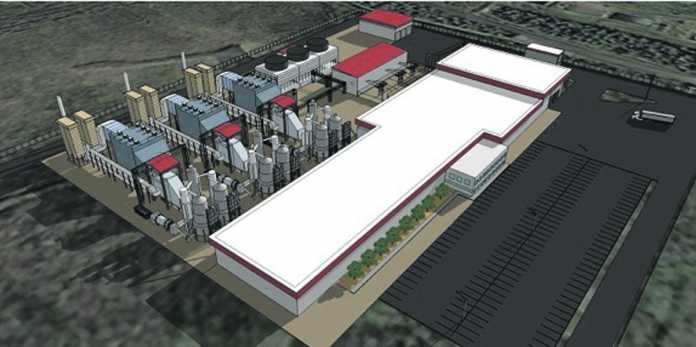
FAMILIES living near the former Gortadroma landfill have expressed anger at plans for a state-of-the-art gasification plant to be built at the site. Now in an exclusive interview with Alan Jacques, the US company behind the project address some of the worries and issues raised by residents of the area.
by Alan Jacques

THE US-based Cadence EnviroPower (CEP) consortium was selected by Limerick City and County Council to develop a waste-to-energy power plant at the former Gortadroma landfill site that will produce up to 40 MW of renewable energy using solid waste as a renewable fuel.
The selection was made from among qualified companies in an open bidding process following more than 18 months of technology evaluations by the local authority and their consultants.
According to Council senior engineer Gerard Doherty, CEP presented a solid technical and economic proposal, based on proven waste gasification technology and equipment, and a highly experienced management.
Prior to signing the agreement for lease of the Gortadroma landfill, which allows CEP to proceed with applying for facility permitting and a waste licence, Council members and local area representatives visited an operating gasification plant in France that generates electrical power using municipal solid waste and biomass as fuel.
This week the Limerick Post had the opportunity to discuss the project with Leonardo Riera, chief executive officer, and Dr Bary Wilson, chief operating officer of CEP, to better understand the scope of the project and to ask about some of the concerns of area residents.
Limerick Post: What is waste gasification, and how is it different from incineration?
Bary Wilson: Gasification is a clean thermal conversion process in which the waste is heated without sufficient oxygen to actually burn (as it does in incineration). The gasification process yields a clean fuel gas, which is then combusted to make steam that is used in a steam turbine generator to produce electrical power. Gasification is widely recognised to be about 18 per cent more efficient than incineration and produces far fewer emissions per kW of electricity produced. Gasification is recognised by any number of academic, industrial and government entities as being the preferred method for conversion of solid waste to energy.
LP: Some people in the area have expressed concerns regarding possible air or water emissions, noise, or dust and odours from the new facility. How does CEP respond to such concerns?
BW: CEP has designed the Gortadroma facility to be as efficient, clean, and quiet as possible. The basic technology and equipment being used has been in reliable operation for more than 30 years. To this basic equipment, CEP has added patent pending technology that further reduces emissions of all kinds.
As shown in the attached sketch of the facility, the incoming waste is processed inside a building to make a refuse derived fuel. This building is maintained at a negative pressure to the outside so that any dust or odors produced inside the buildings do not reach the outside. Instead, these are swept into the gasifiers and destroyed. There is no accumulation of unprocessed waste outside of the facility.
Unlike gasification, the ash produced in the incineration process is a problem for disposal because contains carbon and may contain toxic metals that can migrate into the environment over time. The CEP gasification process removes the carbon from this ash and then converts it to an inert non-leachable material that can be used for architectural fill or for aggregate in concrete of for cement blocks.
Noise measurements made at operating facilities of this type have shown that noise levels in the parking lot (approximately 20 meters from the building) are less than 50 dB (about the noise level of a home refrigerator). In Gortadroma, the facility will be located some 500 meters from the nearest residence and approximately 100 meters from the road. At these distances, there will be essentially no discernible noise from the plant itself. Since there will be a visual barrier comprised of trees in a buffer zone between the plant and the road, the facility will eventually not be visible from the road.
Finally, CEP is commissioning an environmental baseline study by a leading independent Irish environmental consulting company to determine the present condition of the environment in and around the land we will be leasing for the project. The results of this comprehensive study will be a yardstick against which to measure the environmental performance of the new facility. The CEP lease on the land requires that the property be returned to County Limerick in 30 years in the same or better condition than it is at the present time.
LP: Is the gasification of waste any better than just sending the waste to landfills, or exporting the waste to other countries, such as Sweden or Norway?
BW: On a ton per ton of waste basis, gasification generates less greenhouse gas emissions, and less product capable of contaminating groundwater, than placing the same amount of waste in a landfill. This is mainly because landfilling of organic waste generates methane gas which is more than 20 times as harmful as a greenhouse gas than carbon dioxide. Transporting waste offshore amounts to exporting a renewable resource that is better used in Ireland to generate power. Considering the fossil fuels used in transportation of the waste, and the less efficient pollution controls on the cement kilns where most of the waste shipped offshore is used, everyone involved – and the environment itself – is much better off when this resource is used for power generation in Ireland. The 40 MW generated by this Gortadroma plant means 40 MW less that will need to be generated at by costly imported heavy fossil fuel oils.
LP: How many jobs do you expect to create in the area. What other benefits will this facility bring to Limerick and to Ireland?
Leonardo Riera: CEP anticipates that the project will be built in two phases. When in full operation generating 40 MW, we anticipate that the project will create more than 100 new jobs, to include picking line workers, equipment operators, power operators, engineers, plant supervisors, administrative personnel and managers. Hundreds of skilled workers will be involved in the construction of the facility.
Once in operation, in addition to direct jobs, the facility will create the need for a number of local services. It is our policy to give priority to qualified local workers when hiring. Construction of the project will be carried by a combination of international engineering firms with Irish construction companies, providing yet another guarantee that the facility will comply with all local and European regulations, and will have the most advanced technology available today.
LP: Do you plan on involving the community before and after the construction of the project?
LR: Absolutely. We have already interacted with the Councilmen representing neighbours of the area around Gortadroma, and with several neighbours, some of which even visited a gasification facility, and had the opportunity of sharing with us their concerns. All this happened before the contract was awarded and signed.
Limerick authorities and CEP representatives will be organising several events with community leaders and neighbours to provide accurate information about the planned facility and address any concerns. Some of our waste management facilities in Florida, including a newer gasification facility of this type, have become tourist attractions. In Gortadroma, we plan to build a visitors’ center, where the public can come to learn about the local environment and the gasification waste to energy process in general. Once in operation, we plan to help organise visits for schools and for others interested in seeing how waste is turned into clean energy.

LP: What does the project entail as far as investment, and specific flows to County Limerick?
LR: The project will bring some $200 MM of direct investment into the area, and will create the need for some additional local services. County Limerick will receive generous annual payments the lease of the landfill area for the next 30 years. We have also agreed with County authorities to provide an annual fee that can be used for general benefit of local residents as the County sees fit.
We very much look forward to becoming an integral part of this community. We are environmentalists, scientists and experienced utility operators, and trust that the community will see us as working for their benefit.


